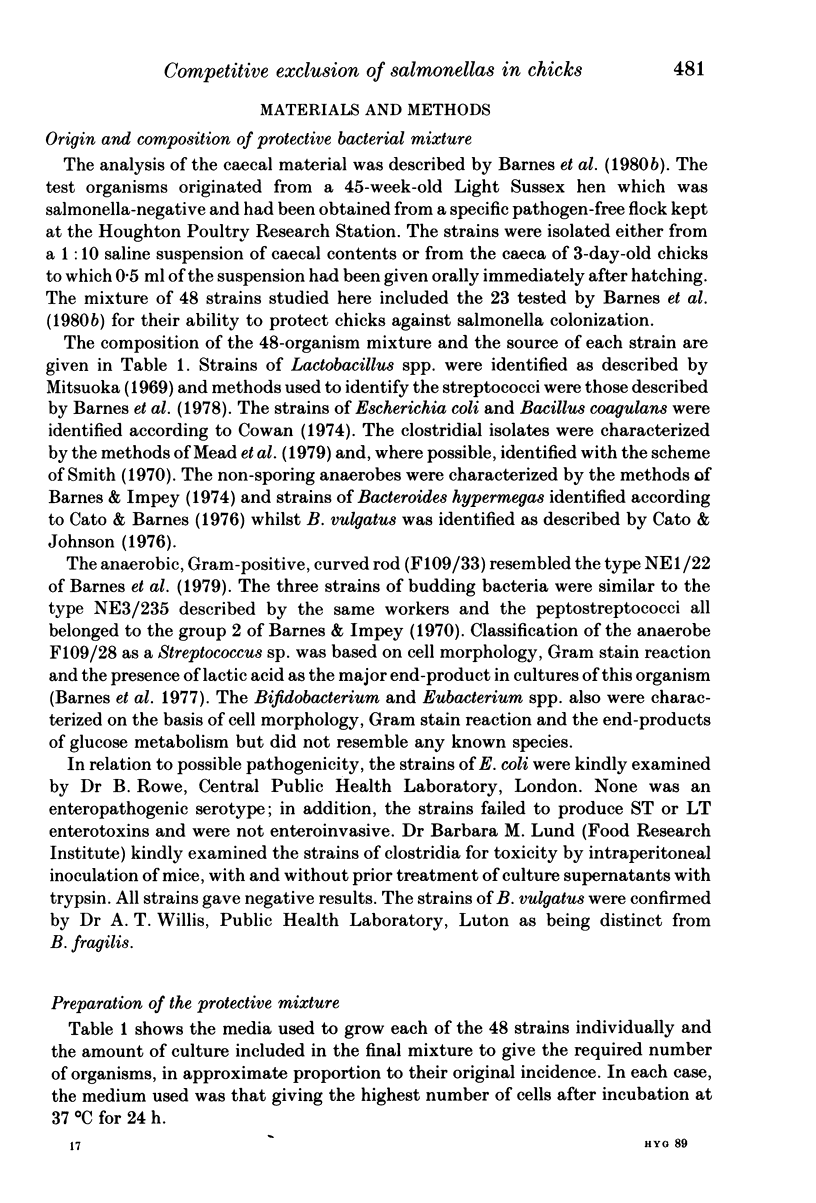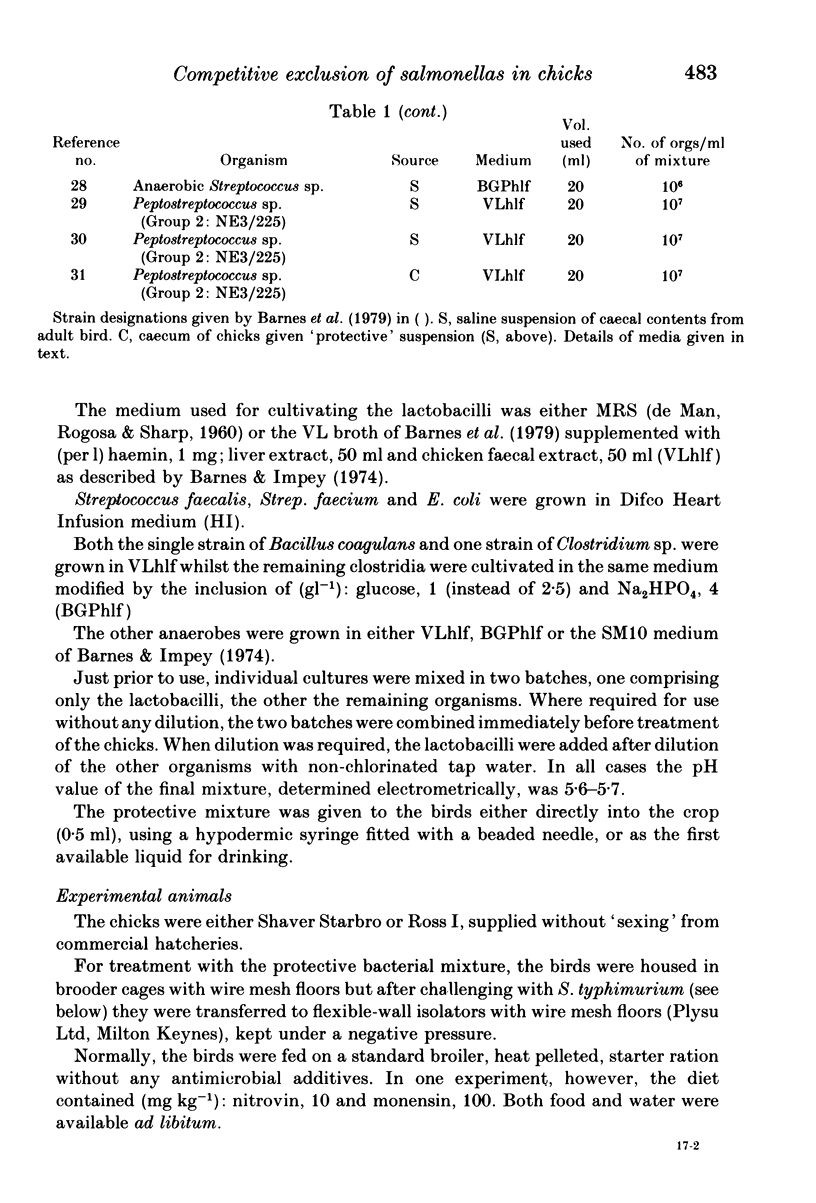Abstract
Colonization of the caeca of newly hatched chicks by Salmonella typhimurium was prevented by oral administration of a mixture of cultures comprising 48 different bacterial strains originating from an adult bird known to be free from salmonellas. The treatment conferred protection to the same degree as that obtained previously with a suspension of adult caecal contents or an undefined anaerobic culture from the same source and was demonstrated in four separate laboratory trials. Examination of the caecal microflora of chicks one day after being given the protective treatment showed that the presence of high levels of lactobacilli and Bacteroides spp. which are not found usually at two days of age in chicks produced under commercial conditions was indicative of the successful establishment of an adult-type microflora. Although the usual method of administering the protective organisms was to dose the chicks directly into the crop, it was also found possible to incorporate the organisms in the drinking water given to the birds at dilutions up to one in five, the maximum tested. When chicks were given the bacterial mixture via the crop and fed on a diet containing 10 mg kg-1 nitrovin and 100 mg kg-1 monensin, the bacteroides failed to establish in the caeca and the birds were not protected against salmonella colonization. However, when the bacterial cultures were incorporated in the drinking water and the chicks given the same feed, normal protection was obtained; possible reasons for these observations are discussed.
Full text
PDF











Selected References
These references are in PubMed. This may not be the complete list of references from this article.
- Barnes E. M., Impey C. S. Anaerobic gram negative nonsporing bacteria from the caeca of poultry. J Appl Bacteriol. 1968 Dec;31(4):530–541. doi: 10.1111/j.1365-2672.1968.tb00402.x. [DOI] [PubMed] [Google Scholar]
- Barnes E. M., Impey C. S., Cooper D. M. Competitive exclusion of salmonellas from the newly hatched chick. Vet Rec. 1980 Jan 19;106(3):61–61. doi: 10.1136/vr.106.3.61. [DOI] [PubMed] [Google Scholar]
- Barnes E. M., Impey C. S., Cooper D. M. Manipulation of the crop and intestinal flora of the newly hatched chick. Am J Clin Nutr. 1980 Nov;33(11 Suppl):2426–2433. doi: 10.1093/ajcn/33.11.2426. [DOI] [PubMed] [Google Scholar]
- Barnes E. M., Impey C. S., Stevens B. J. Factors affecting the incidence and anti-salmonella activity of the anaerobic caecal flora of the young chick. J Hyg (Lond) 1979 Apr;82(2):263–283. doi: 10.1017/s0022172400025687. [DOI] [PMC free article] [PubMed] [Google Scholar]
- Barnes E. M., Impey C. S., Stevens B. J., Peel J. L. Streptococcus pleomorphus sp.nov.: an anaerobic streptococcus isolated mainly from the caeca of birds. J Gen Microbiol. 1977 Sep;102(1):45–53. doi: 10.1099/00221287-102-1-45. [DOI] [PubMed] [Google Scholar]
- Barnes E. M., Impey C. S. The isolation and properties of the predominant anaerobic bacteria in the caeca of chickens and turkeys. Br Poult Sci. 1970 Oct;11(4):467–481. doi: 10.1080/00071667008415842. [DOI] [PubMed] [Google Scholar]
- Barnes E. M., Impey C. S. The occurence and properties of uric acid decomposing anaerobic bacteria in the avian caecum. J Appl Bacteriol. 1974 Sep;37(3):393–409. doi: 10.1111/j.1365-2672.1974.tb00455.x. [DOI] [PubMed] [Google Scholar]
- Dorn P., Krabisch P. Experimentelle Untersuchungen zur Salmonellen-Bekämpfung beim Mastküken durch Substitution der Darmflora. Dtsch Tierarztl Wochenschr. 1981 Feb 5;88(2):54–59. [PubMed] [Google Scholar]
- Edel W., Kampelmacher E. H. Salmonella isolation in nine European laboratories using a standardized technique. Bull World Health Organ. 1969;41(2):297–306. [PMC free article] [PubMed] [Google Scholar]
- Lloyd A. B., Cumming R. B., Kent R. D. Prevention of Salmonella typhimurium infection inpoultry by pretreatment of chickens and poults with intestinal extracts. Aust Vet J. 1977 Feb;53(2):82–87. doi: 10.1111/j.1751-0813.1977.tb14891.x. [DOI] [PubMed] [Google Scholar]
- MILNER K. C., SHAFFER M. F. Bacteriologic studies of experimental Salmonella infections in chicks. J Infect Dis. 1952 Jan-Feb;90(1):81–96. doi: 10.1093/infdis/90.1.81. [DOI] [PubMed] [Google Scholar]
- Mead G. C., Adams B. W., Hilton M. G., Lord P. G. Isolation and characterization of uracil-degrading clostridia from soil. J Appl Bacteriol. 1979 Jun;46(3):465–472. doi: 10.1111/j.1365-2672.1979.tb00845.x. [DOI] [PubMed] [Google Scholar]
- Mead G. C., Adams B. W. Some observations on the caecal microflora of the chick during the first two weeks of life. Br Poult Sci. 1975 Mar;16(2):169–176. doi: 10.1080/00071667508416174. [DOI] [PubMed] [Google Scholar]
- Mitsuoka T. Vergleichende Untersuchungen über die Laktobazillen aus den Faeces von Menschen, Schweinen und Hühnern. Zentralbl Bakteriol Orig. 1969 May;210(1):32–51. [PubMed] [Google Scholar]
- Nurmi E., Rantala M. New aspects of Salmonella infection in broiler production. Nature. 1973 Jan 19;241(5386):210–211. doi: 10.1038/241210a0. [DOI] [PubMed] [Google Scholar]
- Rantala M. Cultivation of a bacterial flora able to prevent the colonization of Salmonella infantis in the intestines of broiler chickens, and its use. Acta Pathol Microbiol Scand B Microbiol Immunol. 1974 Feb;82(1):75–80. doi: 10.1111/j.1699-0463.1974.tb02295.x. [DOI] [PubMed] [Google Scholar]
- Rantala M. Nitrovin and tetracycline: a comparison of their effect on salmonellosis in chicks. Br Poult Sci. 1974 May;15(3):299–303. doi: 10.1080/00071667408416110. [DOI] [PubMed] [Google Scholar]
- Rantala M., Nurmi E. Prevention of the growth of Salmonella infantis in chicks by the flora of the alimentary tract of chickens. Br Poult Sci. 1973 Nov;14(6):627–630. doi: 10.1080/00071667308416073. [DOI] [PubMed] [Google Scholar]
- Rigby C. E., Pettit J. R. Observations on competitive exclusion for preventing Salmonella typhimurium infection of broiler chickens. Avian Dis. 1980 Jul-Sep;24(3):604–615. [PubMed] [Google Scholar]
- Snoeyenbos G. H., Weinack O. M., Smyser C. F. Further studies on competitive exclusion for controlling Salmonellae in chickens. Avian Dis. 1979 Oct-Dec;23(4):904–914. [PubMed] [Google Scholar]
- Snoeyenbos G. H., Weinack O. M., Smyser C. F. Protecting chicks and poults from Salmonellae by oral administration of "normal" gut microflora. Avian Dis. 1978 Apr-Jun;22(2):273–287. [PubMed] [Google Scholar]
- Soerjadi A. S., Lloyd A. B., Cumming R. B. Streptococcus faecalis, a bacterial isolate which protects young chickens from enteric invasion by Salmonellae. Aust Vet J. 1978 Nov;54(11):549–550. doi: 10.1111/j.1751-0813.1978.tb00337.x. [DOI] [PubMed] [Google Scholar]


